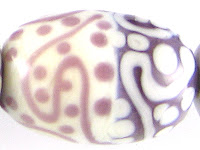1 - Plain, 2 - Plain (reduced), 3 - w/ Silver Leaf, 4 - w/ Silver Leaf (reduced & encased), 5 - w/ TerraNova2 Frit, 6 - w/ Silver Glass Frit (reduced), 7 & 8 - w/ Tuxedo, Copper Green, Opal Yellow, Ivory, Peace
CiM Jade Palace is a medium, teal semi-opaque. It seems a little like it might be a lighter version of CiM Rainforest, however the reactions I got with Jade Palace aren't really all that similar to the reactions I got with Rainforest, so it is materially a different colour as far as I am concerned.
When silver leaf is used on top of Jade Palace, it disperses into a fine silvery mist. Underneath the silver leaf, the Jade Palace has struck to a darker version of itself, but I can't be certain whether this happened because of the silver or if it struck because of some repeated heating and cooling. I'm not sure how many times I pressed this bead, which doesn't really help any of us know for sure.
When I encased reduced silver leaf on top of Jade Palace, it turned decidedly gold. I believe I was using Reichenbach Crystal Clear for this test. You can probably see that the bead split in half along the mandrel line as well, which could be my fault, but also might be due to the differing viscosity between the Reichenbach clear and the Jade Palace because Reichenbach Crystal Clear is a very stiff colour, whereas Jade Palace is very soft and runny. I had a similar problem encasing Mulberry with Effetre 006 clear for possibly the same reason. The jury is still out.
It looks like Jade Palace is a little nicer as a base for striking silver glass than it is for reducing silver glass. I got a great start to my strike in the TerraNova2 frit bead, but not a lot of magic happened there. In the bead with the reduced silver glass frit, the frit and reduction seems to have fumed the Jade Palace to a yellower, greener version of itself but the appearance of the frit is sort of smeary and lackluster.
Jade Palace does not do much in the way of reaction with Tuxedo, but it does some crazy things with the other colours I tested it with.
Copper Green
On top of Jade Palace, Copper Green separates into a reddish, shiny colour and a darker teal colour. A faint lighter line is visible around the edges of the Copper Green stringer and dots. I observed something silimar with Seafoam, however with Seafoam the lighter line was much more regular and pronounced than it is here with Jade Palace.
When Jade Palace is used on top of Copper Green, the greenish colour of the Jade Palace gathers in the centre of the dots and stringer lines, surrounded by a light turquoise line, all surrounded by a deeper, dark turquoise. This is a pretty neat reaction, however in the centre of the dots and stringer lines I also got some random sooting/blackening which sort of mars the overall effect.
Opal Yellow
Opal Yellow separates on top of Jade Palace and underneath it. The light yellow halos that pop up around Jade Palace stringerwork are very interesting and worth some playtime if you happen to have some of this colour. I like how the Jade Palace seems to forget that it is semi-opaque and looks very transparent over Opal Yellow.
Ivory
On top of Jade Palace, Ivory separates, gets a dark line reaction and curdles... ALL AT THE SAME TIME. The Jade Palace underneath stays more or less like itself, not getting all curdled the way Seafoam did. This is very similar to how Ivory reacted with Rainforest, although this reaction is quite a bit more dramatic than that one was.
On top of Ivory, Jade Palace turns into a darker, browner version of itself and spreads quite a lot, brown webbing spreading all over the Ivory. Underneath the Jade Palace, the Ivory curdles.
Peace
Peace separates on top of Jade Palace. When Jade Palace is used on top of Peace, the Peace separates underneath it, white halos popping up around the Jade Palace. The Jade Palace goes very transparent and a very dark line forms in the middle of the Jade Palace stringerwork.















































